EBR charges a service fee to manufacturers to produce ebike reviews and videos. It’s the same flat fee for each bike, and it helps us to keep the site going while limiting ad clutter. We appreciate the opportunity to serve you with our opinions and data but respect your right to know that we receive compensation :)
PIM (Power in Motion) offers a range of unique, higher-quality electric bike models for 2017/2018 season with two prominent frame styles – high step and step through – and many shared components throughout the lineup. PIM’s newest iteration, the Archer, builds upon their previous iterations and this model looks like a rugged urban electric bicycle that could handle some rough city streets and even some casual off-road dirt and gravel trails. It offers a 750-watt gearless, direct-drive hub motor with 51 Newton meters of torque that can propel the Archer up to a maximum pedal-assist speed of 25 mph for an estimated 20 to 30 miles per charge. Regenerative braking can potentially increase the range of the Archer and there are three interesting ways it can be activated. First, if the bike is in a negative pedal-assist setting, the regen braking will automatically activate when going downhill. I tested this function during the ride portion of this review and it seemed to work pretty well, keeping the bike at a constant speed even when traveling down a slight decline. Second, the regen braking can be activated by back pedaling. This also appeared to work well, was similar to the FlyKly or Superpedestrian Copenhagen Wheel, and slowly brought the bike to a stop on flat ground. Third, the regen braking can be activated more traditionally by a light press on either of the adjustable-reach Magura brake levers. The brake levers are hinged and when pressed lightly there’s an audible and tactile click to signal the regen braking has been activated. There’s also a motor inhibitor wired into the brakes, which means any brake activation (regen or hydraulic disc brakes) will cut power to the motor. This is a great feature as it ensures the rider won’t be fighting against the power of the motor while trying to brake and it ensures maximum braking potential and minimum wear on the motor itself. Pedal assist is super responsive on this ebike so those brake lever motor inhibitors really come in handy for simple control, even at low speeds. The Archer’s frame and handlebars are made from 6061 aluminum alloy, giving the bike a pretty hefty curb weight of 57 lbs, but even though the hub motor is in the back, the bike felt more balanced than I expected, probably because of the 8 lb battery integrated into the downtube. And speaking of the battery, I liked that it completely disappears into the frame instead of jutting out above it like on some other electric bikes. Also, and while it’s a minor thing, I really liked that the battery had a hinged flap to cover the charging port. More often than not I find the rubber grommets on electric vehicles that are supposed to protect the charging ports come off while riding or are difficult to seat, but it looks like the hinged flap on the Archer will stay firmly in place. This should help keep water and debris out of the charging port. The only downside to the battery is there isn’t a USB charging port, which would be awesome to include in a future model for those riders who want to charge accessories while riding or by using the battery as a portable power bank. There’s also a bit more effort required to connect the battery when seating it into the frame because it uses a plug there vs. a seating interface. The good news is, the battery can be charged on or off the bike by using the same standard charger, without any dongle adapters.
There’s a handful of other features on the Archer that were new to me as well. I briefly mentioned the pedal-assist modes above, but I think it’s worth diving in a bit deeper into how those work. On the Archer, there’s five pedal assist modes: -2, -1, 1, 2 and 3. When in -2 and -1 mode, the motor doesn’t give much assistance when pedaling on flat terrain – a fact that makes makes the 57 lb curb weight painfully noticeable – but the motor does start to kick in when pedaling uphill. Additionally, the automatic regenerative braking activates when the bike starts picking up speed without pedaling. This is an interesting feature as I think using these negative pedal assist modes could increase the max range quite a bit, as well as give the rider a bit of a workout as well. But it’s not until I kicked it into the positive pedal-assist modes that I really felt the power of the 750-watt motor. The Gripshift gear shifter on the right side of the handlebars also helps select how much pedal assist you want. So it’s like, you’re changing gears and changing power level all with the same shifter mechanism. The Archer fed me more and more power as I switched up through the gears, which is exactly what it’s supposed to do… but it also slowed my cadence because the gears were changing, and that connection meant that I had to match the bike vs. pedaling at my own preferred cadence and selecting assist power separately. The Grip shifter feels kind of like a throttle in a way because every time you give it a twist, you unlock a little bit more power. When I hit fifth gear I really felt the pedal-assist and zipped across a grassy field without any problem. And the cadence sensor – which isn’t magnetic like most cadence sensors, but instead works by feeding the chain through a separate, small sprocket that connects to a circuit board – is incredibly responsive. The slightest pedaling motion activates the motor, although it felt like the motor remained on for a little longer than necessary after I stopped pedaling, which may have been a conscious design choice by the team to reduce the feeling of surge. This could make traveling at a low rate of speed somewhat difficult because you might still be getting situated and make a little pedal motion that will activate the bike right away, but honestly I feel like it’s worth it because of the extra sensitivity you get from the cadence sensor.
Comfort wise, the Archer felt nice. The ergonomic rubber grips were soft and the texture of the rubber felt good to my hands – like the material you find on Apple cords. The Kore seat was also comfortable. Braking was a breeze with the hydraulic 180 mm disc brakes and I was able to easily bring the bike to a stop with just one hand while filming! That being said, there was a slight grinding noise on harder stops, and I’m not exactly sure what was causing that. It could be the punched out design of the rotors, meant to reduce weight and improve cooling, that can make some noise when the brake pads vibrate across the surface. PIM worked with Kenda to create custom tires for the Archer, and these tires are kevlar reinforced – a feature I greatly appreciate as the area I ride is filled with nasty, little thorns that seem intent on puncturing my tires. Seriously, I get flats on almost every other ride. Rather than using a more traditional 2.25″ diameter on the tires, PIM opted for 3.0″ which is a plus size which provides more air volume for comfort and stability. This adds weight, but that is managed well by the sturdy extra thick axles with 12 mm at the back and a 15 mm thru-axle up front. I wasn’t able to really put these tires to the test, but I still think it’s an interesting point to note. The Magura TS6 suspension on the Archer worked well, even for a 200 lb rider like me. I didn’t feel much dive when braking, but if I had the suspension can be sagged by increasing or decreasing the air pressure or locked out completely with the compression dial on top. The regen braking also functioned as advertised, bringing me to a slow stop when activated either through the brake levers, backpedaling or by going downhill in a negative pedal-assist mode.
Priced at $1795, the Archer feels like a good mid-range bike with some above-average features like sealed bottom bracket crank and headset bearings – which should help keep water and debris out and increase the overall longevity of the bike – a motor inhibitor, kevlar reinforced tires, a super accurate cadence sensor, a Gripshift that also acts a bit like a throttle, and a fully-integrated, streamlined battery to name a few. Big thanks to PIM for partnering with me on this review and to Ben for driving all the way out to California to come hang out with me and show me the Archer. I tried to be independent and share my complaints or concerns when looking at the bike with him but appreciate the help he offered in taking the battery off and also explaining the cadence sensor technology. I love that the chainring has a guard on the outside to protect your pants and keep the chain on track and that the cadence sensing pulley wheel doubles as a guide so there’s less slap and fewer chain drops in general. Also, the rear portion of the bike is setup with rack bosses so you you could outfit this thing for commuting or probably put a fender on to keep your back clean. Some things it did not have were bottle cage bosses, integrated lights, or a USB charging port for use with portable electronics like lights. The display itself is backlit and looks nice but not removable, so it could take some wear in rainy or harsh conditions but I usually leave my helmet over top to keep it protected, so there are some options.
In closing, I have a few things to add and clarify. It’s neat that PIM motor sensor can actually tell that you’re climbing or going down a hill. Their -1 and -2 mode are very unique in the world of electric bicycles, in that they do not constantly regenerate the way that some of the BionX motors do (for exercise or to simulate hills) they just focus on terrain and add power when necessary or strive to slow you down when descending. In practice, I’m not sure how much I would use these because the bike is still heavy on flats and it’s great to have real assist there vs. very minimal support. Considering that this bike comes with a four amp charger and a 12 volt car charger, that shipping is just $150 in the contiguous USA and that PIM is opening a flagship store in Ballard Washington at 4013 Leary Way, NW Seattle, Washington 98107 in mid-December 2017 (so you can actually test ride their products and buy in person if you live nearby) makes the sub-$2k price point seem pretty reasonable. Especially for such a custom frame and nicer hydraulic disc brakes and motor/controller designs. I look forward to reviewing some of the other PIM products that start at just $1,495, including a fat e-bike, to see how they perform in more varied terrain.
Pros:
- The Archer has a motor inhibitor which cuts power to the 750-watt hub motor whenever the regen brakes or hydraulic disc brakes are activated, a great feature that should prevent unnecessary wear on the brakes and motor
- Regen braking can be activated by a light press on the adjustable-reach brake lever, back pedaling or by riding downhill while in a negative pedal-assist mode and can be used to slowly bring the bike to a stop while also feeding some extra juice back into the battery, this can also help increase the lifespan of the brake pads themselves if used in lieu of the disc brakes
- Gripshift gear shifter also acts as a sort of throttle, giving the rider increased control over how much pedal assist they want from the motor, it’s also a cool feature that reminds me of riding traditional dirt bikes
- 180 mm hydraulic disc brakes in the front and rear provide ample stopping power
- Magura MTS suspension is adjustable to accommodate a variety of ride styles and riders of various weights
- While the curb weight of the Archer is relatively heavy at 57 lbs, the bike is relatively well balanced thanks to the hub motor in the rear and the 8 lb battery in the downtube
- Sealed crank and stem bearings should help keep water and debris out and prevent rusting, a nice little upgrade that isn’t necessary but can increase the overall lifespan of the bike
- The unique cadence sensor setup makes the pedal assist extremely accurate and allows it to activate with the slightest bit of pedaling, making it feel a bit like a torque sensor
- The fully integrated battery disappears into the downtube making for a lower profile electric bike and, in my opinion, more aesthetically pleasing than battery packs that jut out above the frame, I also appreciate the hinged cover on the charging port that stays perfectly in place until you physically move it out of the way to charge, it’s also easily removable with just a simple twist of a key and by pulling off the connecting cable inside the frame
- The 750-watt motor with 51 Newton meters of torque felt powerful and while I was only able to take it through some grass and some slight inclines, I believe it would perform well on steeper hills and even on some casual trails
- The suspension and apparent rigidity of the frame means the Archer can likely tackle even the roughest city streets and probably even some dirt and gravel trails
- Kevlar-reinforced tires should help reduce the likelihood of punctures, a feature I especially appreciate because of the many thorns in my area
- 25 mph top pedal-assist speed is good for those who want a bit more speed out of their electric bikes, and with the 750-watt motor this top speed should be reachable for most riders
- The display center is easy to operate and has a backlit LCD screen so it can be used in low light conditions as well as daytime
- The various pedal-assist modes offer a pretty unique riding experience as far as electric bikes go, with negative pedal-assist modes it feels more like a traditional bike until you get to hills, while the positive pedal-assist modes feel more like a traditional electric bike where the motor activates whenever you pedal
- A $1795 price tag makes the Archer relatively affordable and I think with the many features it has it makes it a good value purchase
- Power in Motion is opening a flagship store in Ballard Washington so you can go and see their products in person and take test rides if you live nearby, otherwise they are a direct to consumer online brand to keep costs lower
Cons:
- A curb weight of 57 lbs isn’t the lightest, and pedaling the Archer on a negative pedal assist setting or with the bike powered off is, naturally, more difficult than pedaling a traditional bike or even a lighter electric bike
- There’s no integrated lights, and no apparent way to hardwire aftermarket lights into the electrical system, so for those who want aftermarket lights to ride at night or just for increased visibility during the day, the only option is an entirely self-contained unit
- The control center is nice and does offer some of the more pertinent information like current speed and trip timer, but there’s no tripometer or cadence measurement, and there’s no way to change the configuration of the display
- The cadence sensor itself is extremely accurate and activates with the slightest pedaling motion, but because it’s still a cadence sensor the power comes on at full force and it takes at least a half-second, sometimes a full second, for the power to shut off after I stopped pedaling, which can make riding at slow speeds somewhat jerky and difficult
- The battery doesn’t have a USB port to charge accessories while riding or while the battery pack is separate from the bike
- The model I tested had a slight grinding noise during harder braking and even if that doesn’t causing mechanical wear, the noise is loud enough to be a bit aggravating
- PIM only ships to the United States
- Doesn’t have bottle cage bosses but at least there are threaded eyelets for a rear rack if you need to carry some gear if you want
- It takes a bit more screwing around to get the battery off of the bike because of the power cord inside the frame, this pack doesn’t interface directly but plugs in with a dongle
- It appears that this ebike is only sold direct online vs. through shops, so that means you might not get to try it out and you might have some extra trash and assembly work before it’s ready to go if you do buy it
- I personally like that the Gripshift acts as a sort of throttle, but there doesn’t appear to be a way to turn that off, so those riders looking for more of a traditional electric bike setup are forced to stick with this layout
Resources:
- Official Site: http://www.pimbicycles.com/product/ds-1/
- More Pictures: https://photos.app.goo.gl/s6dFMv6blBgK9w912

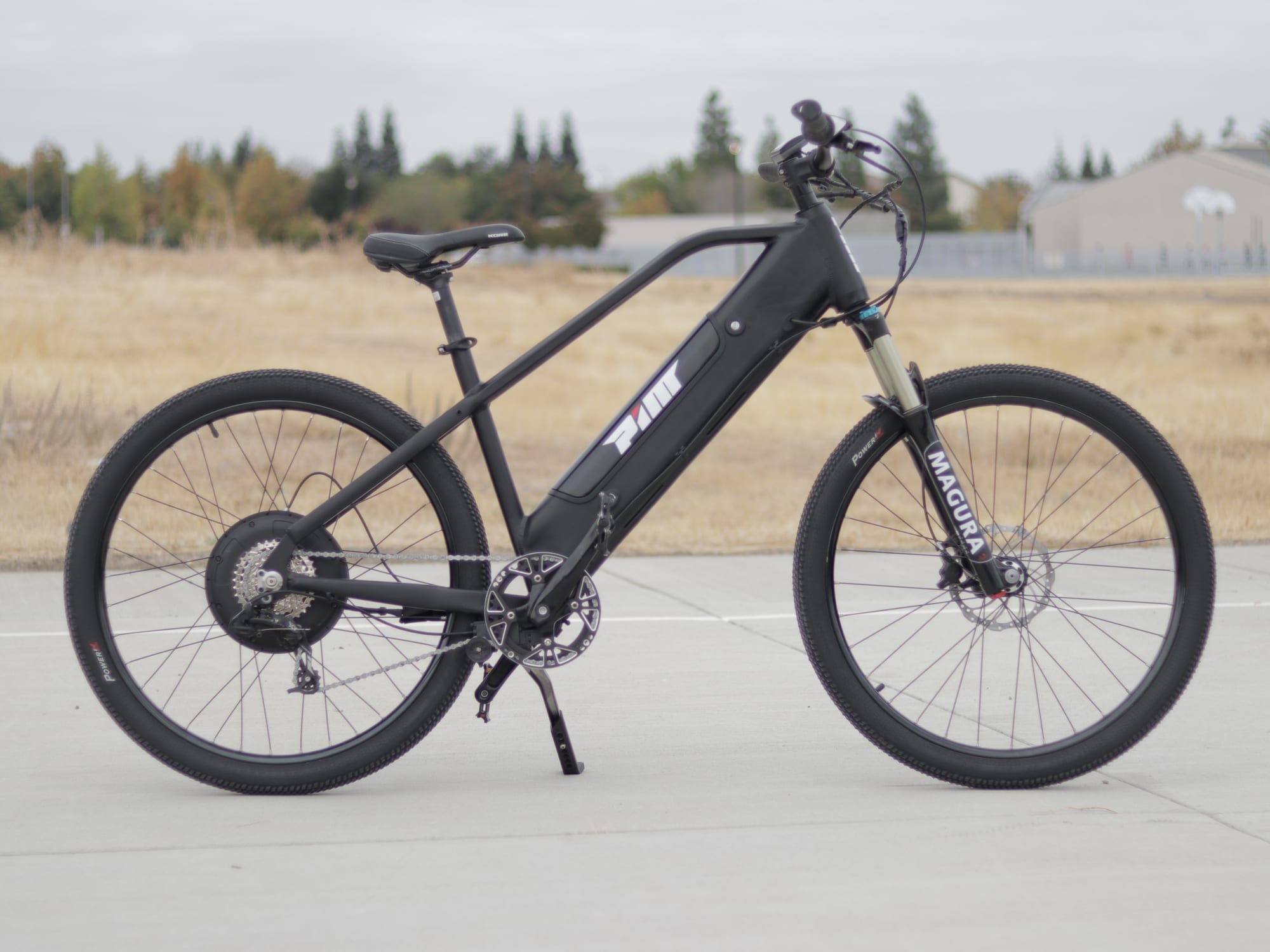

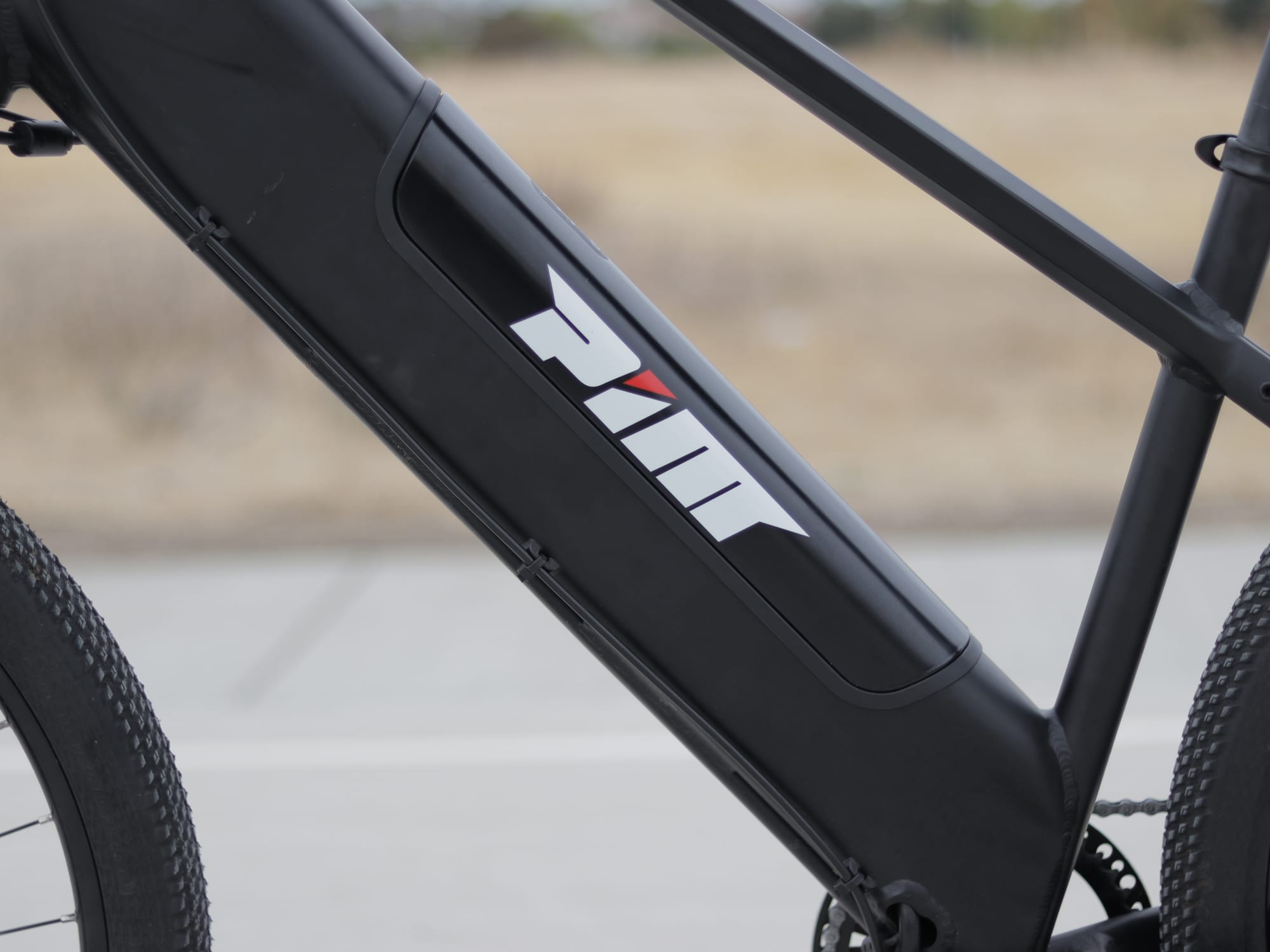
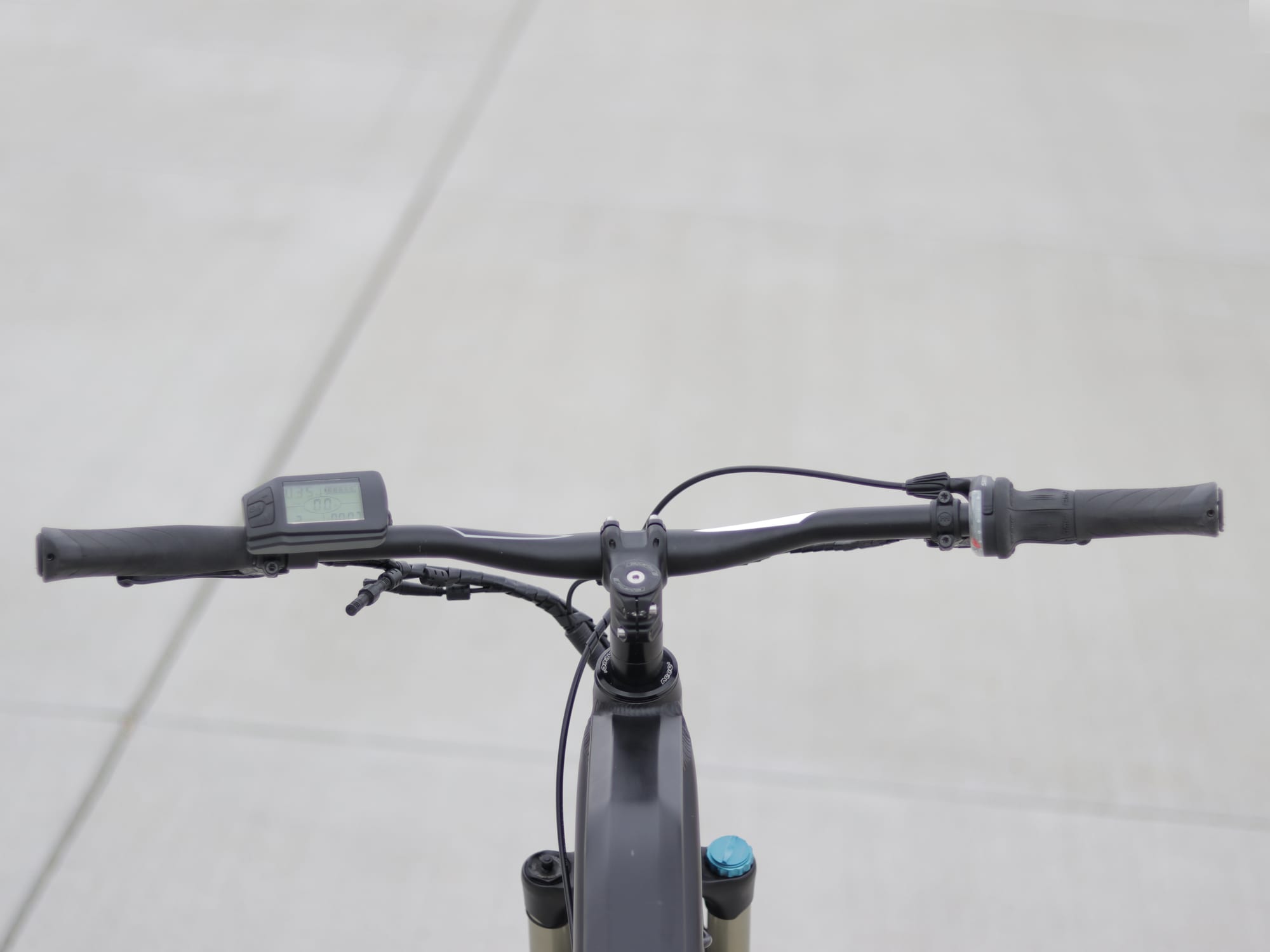
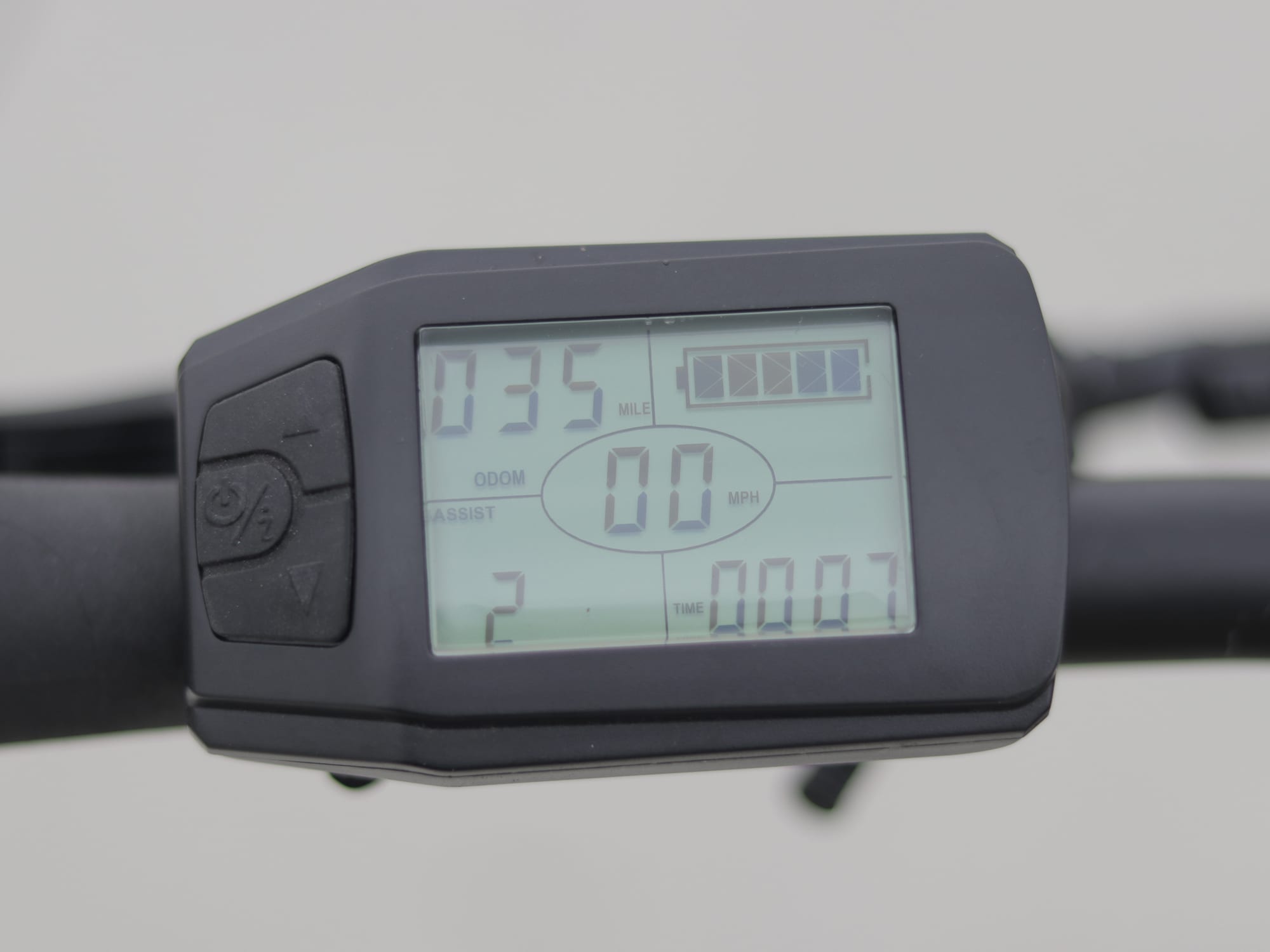
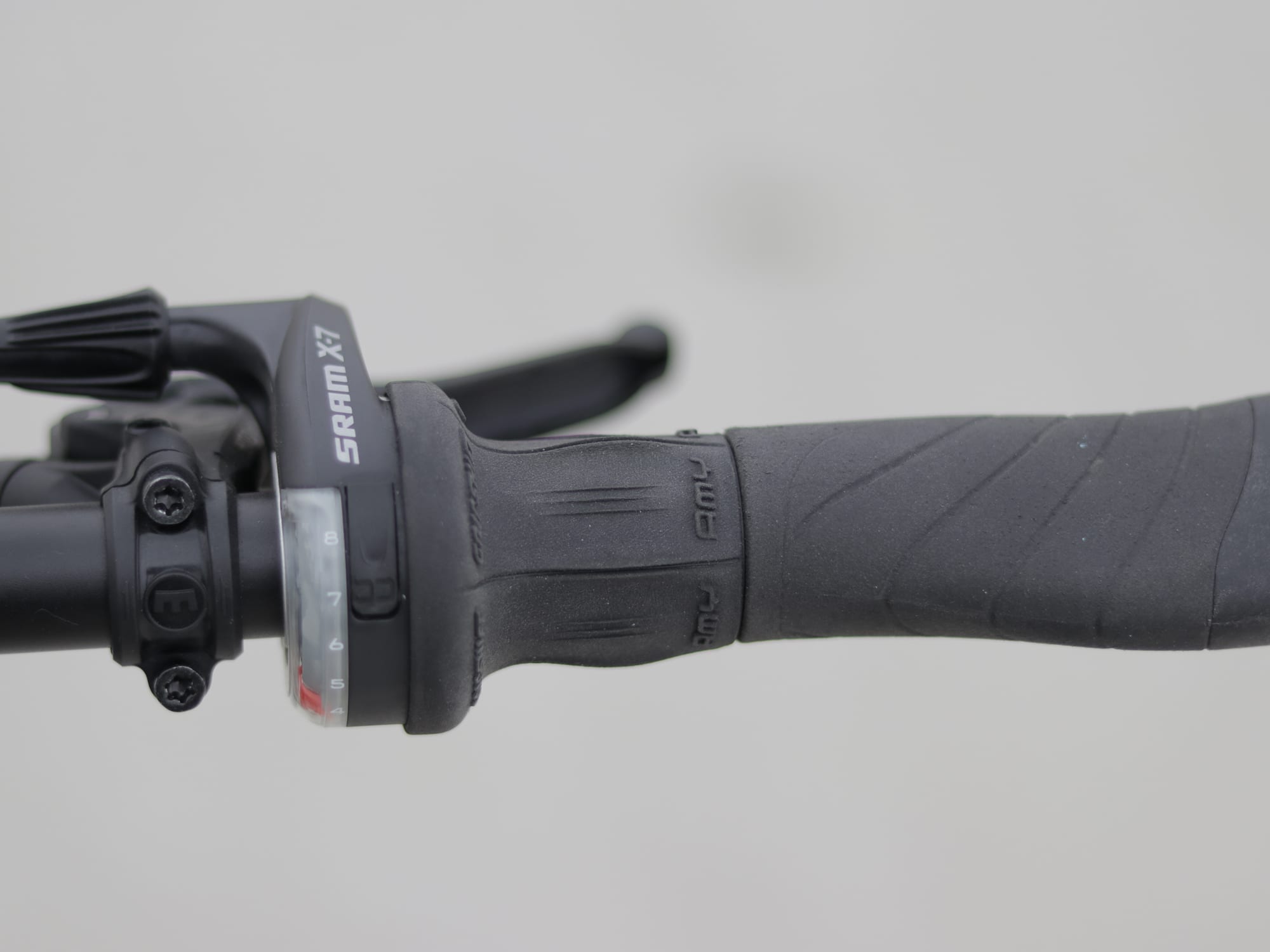

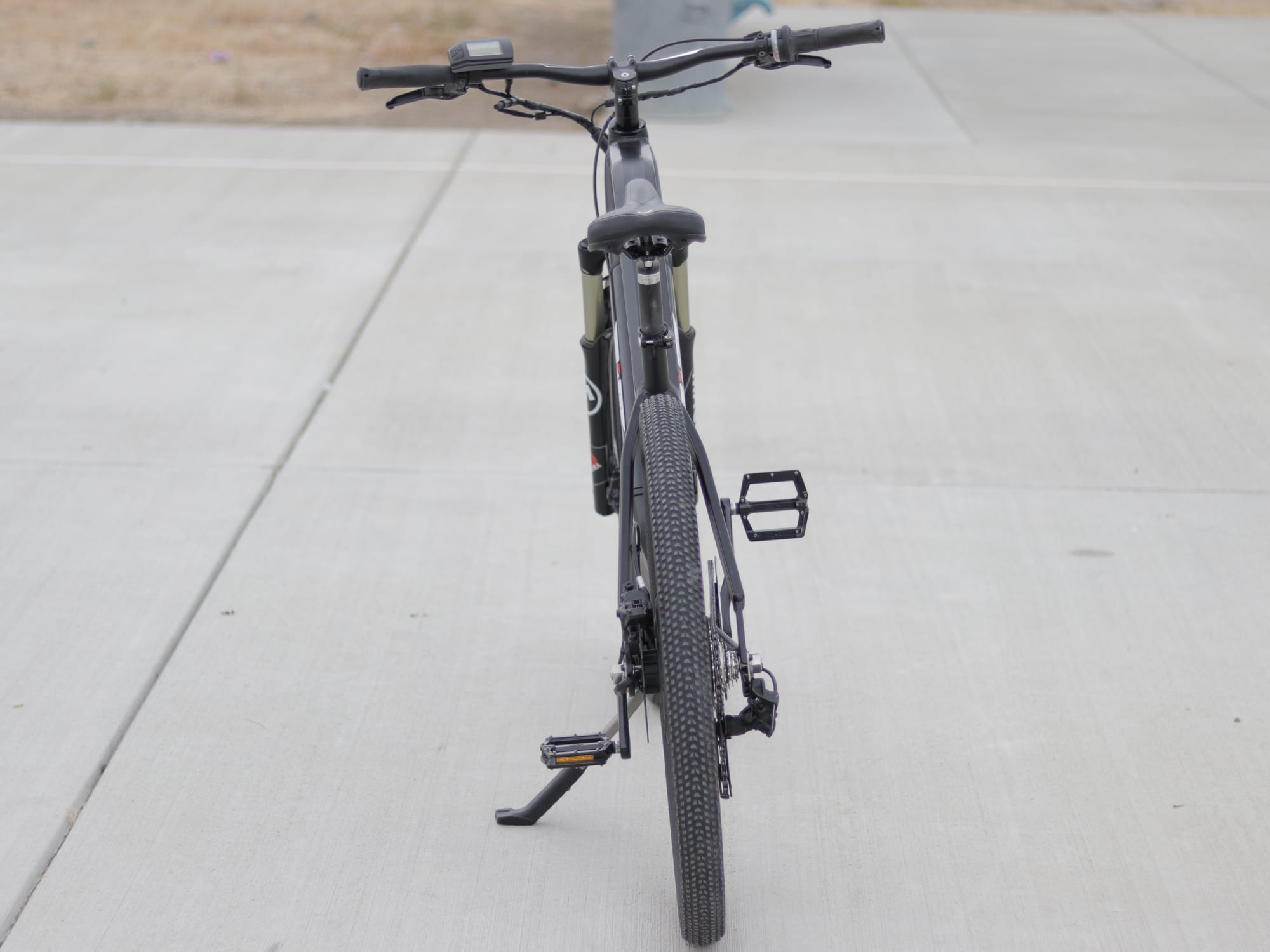
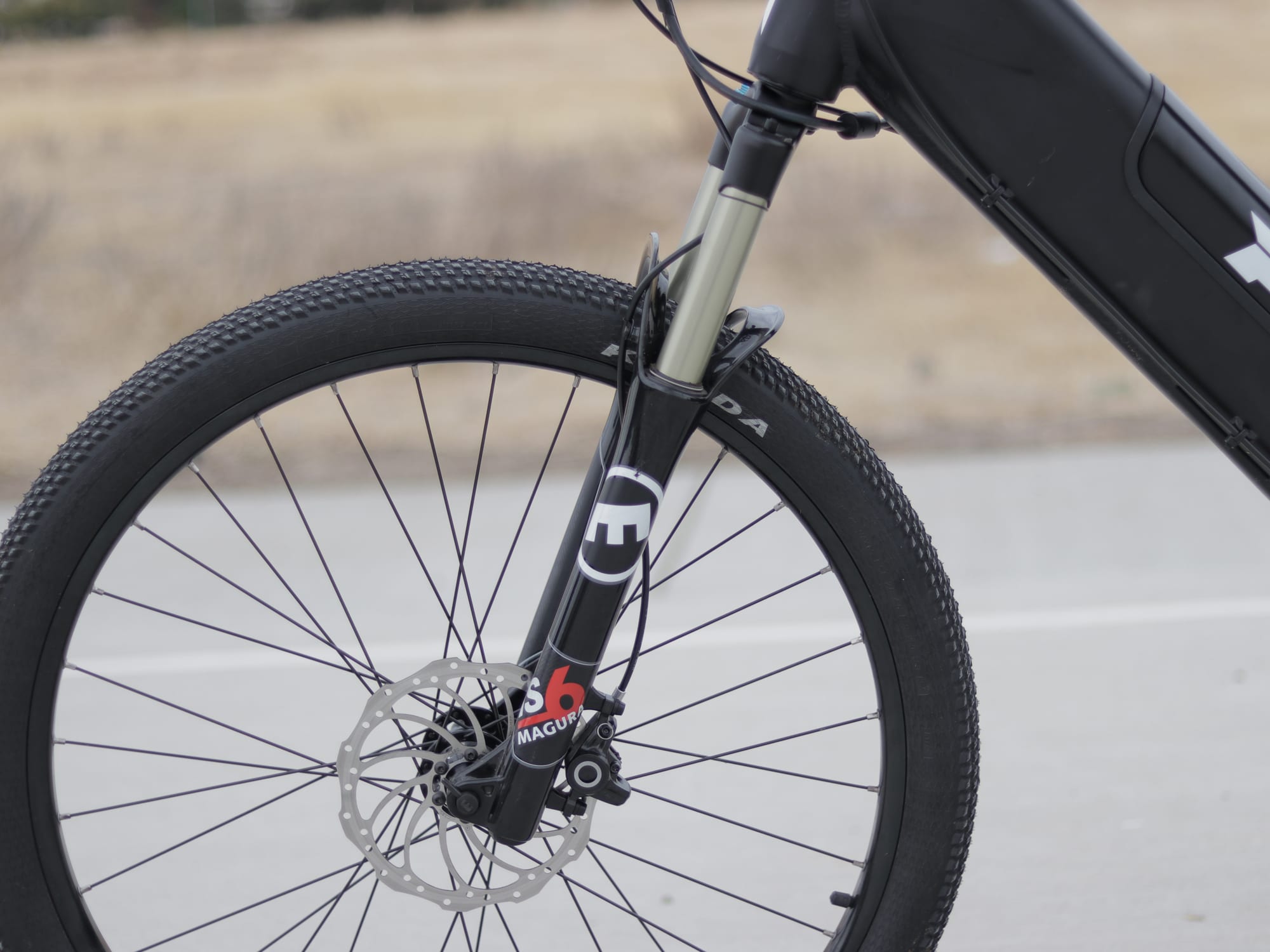
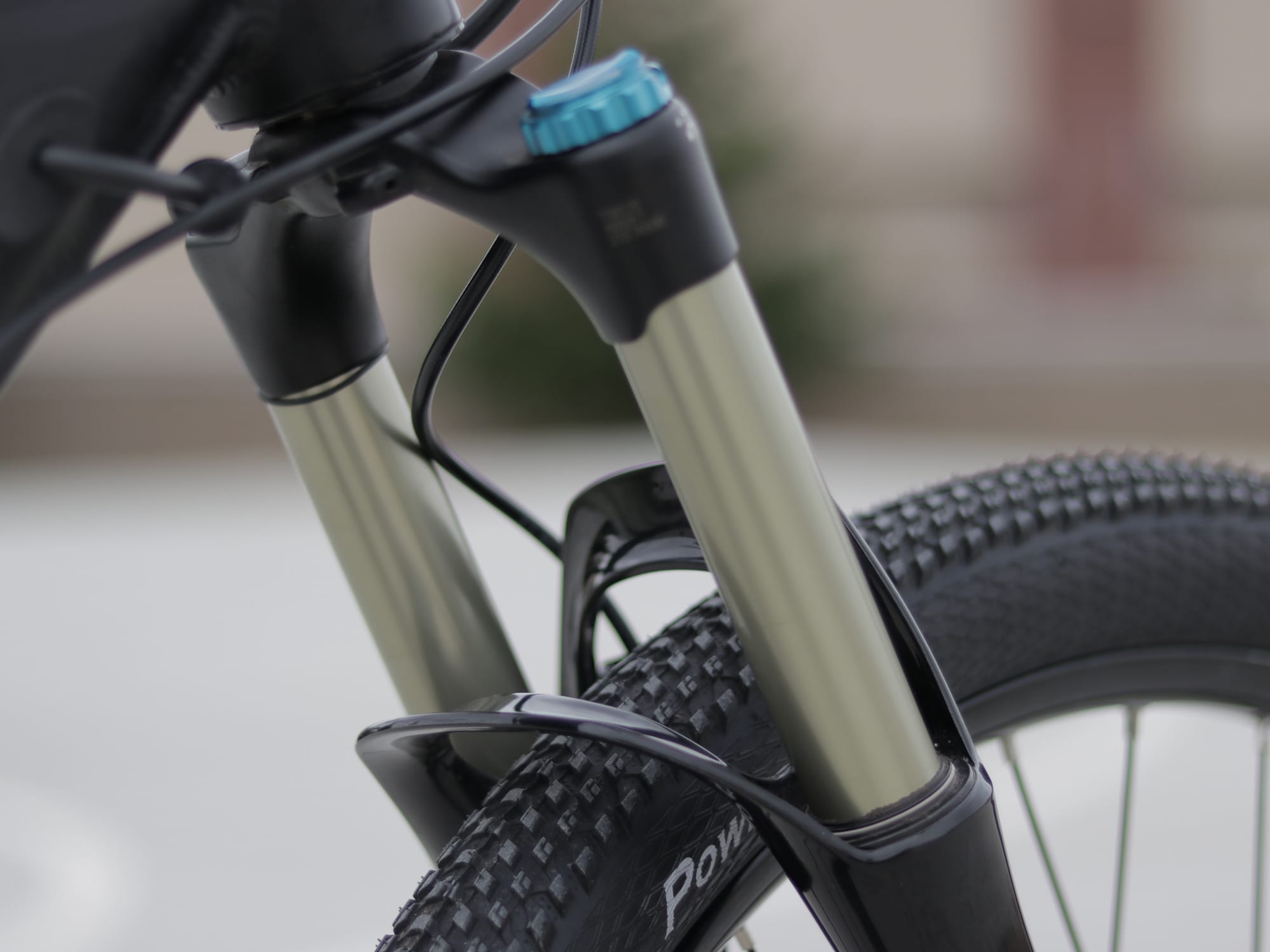
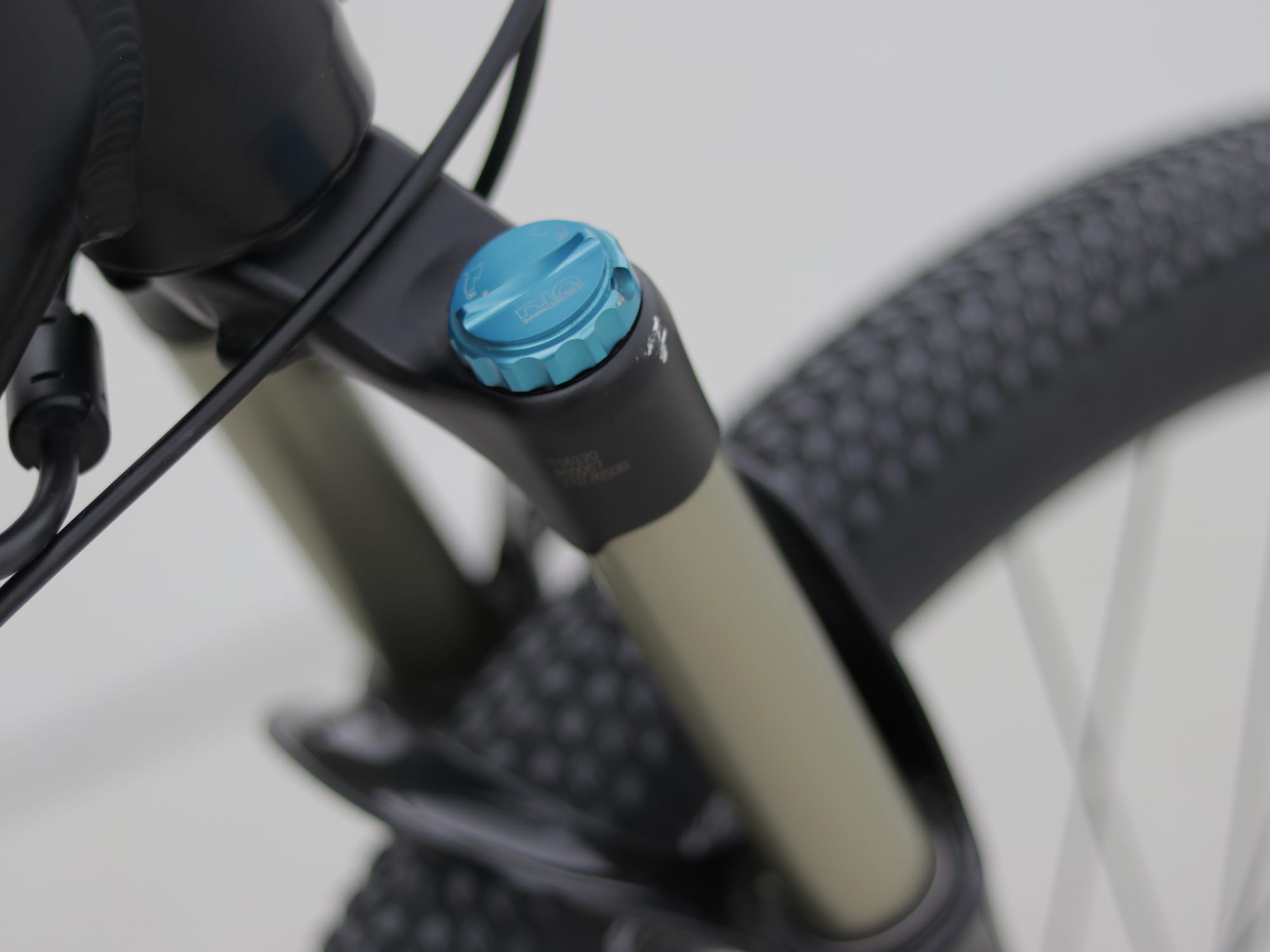

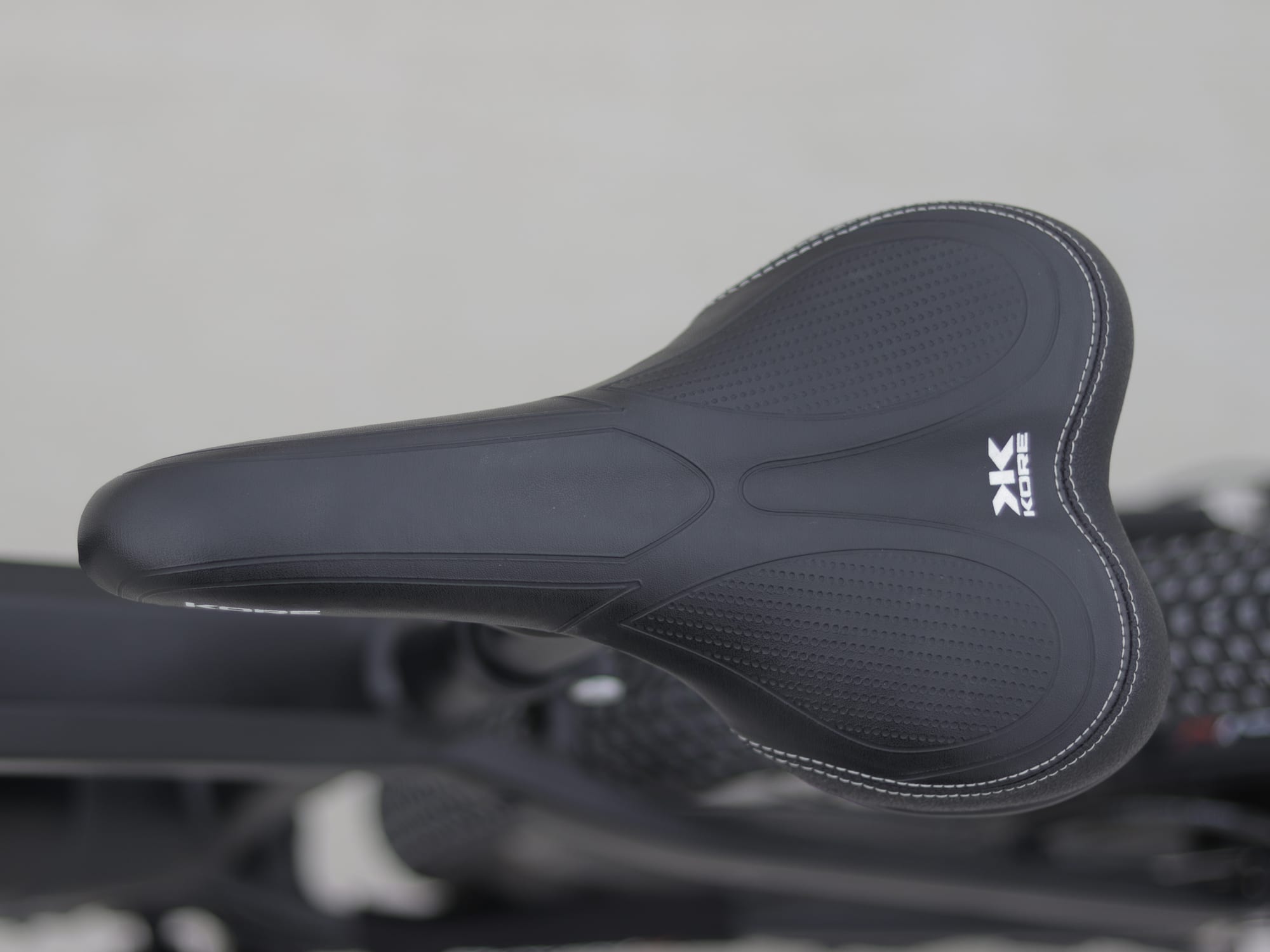
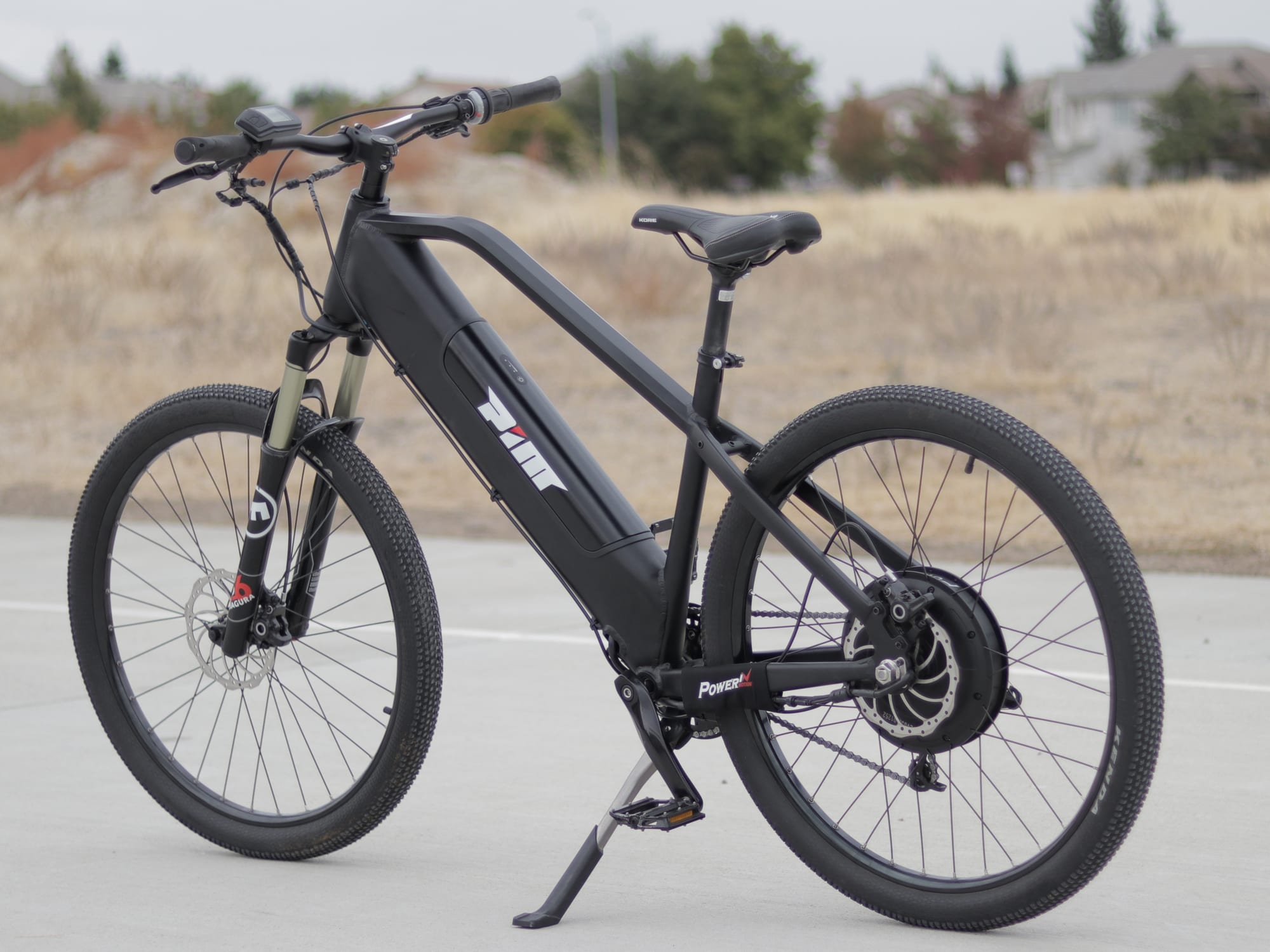
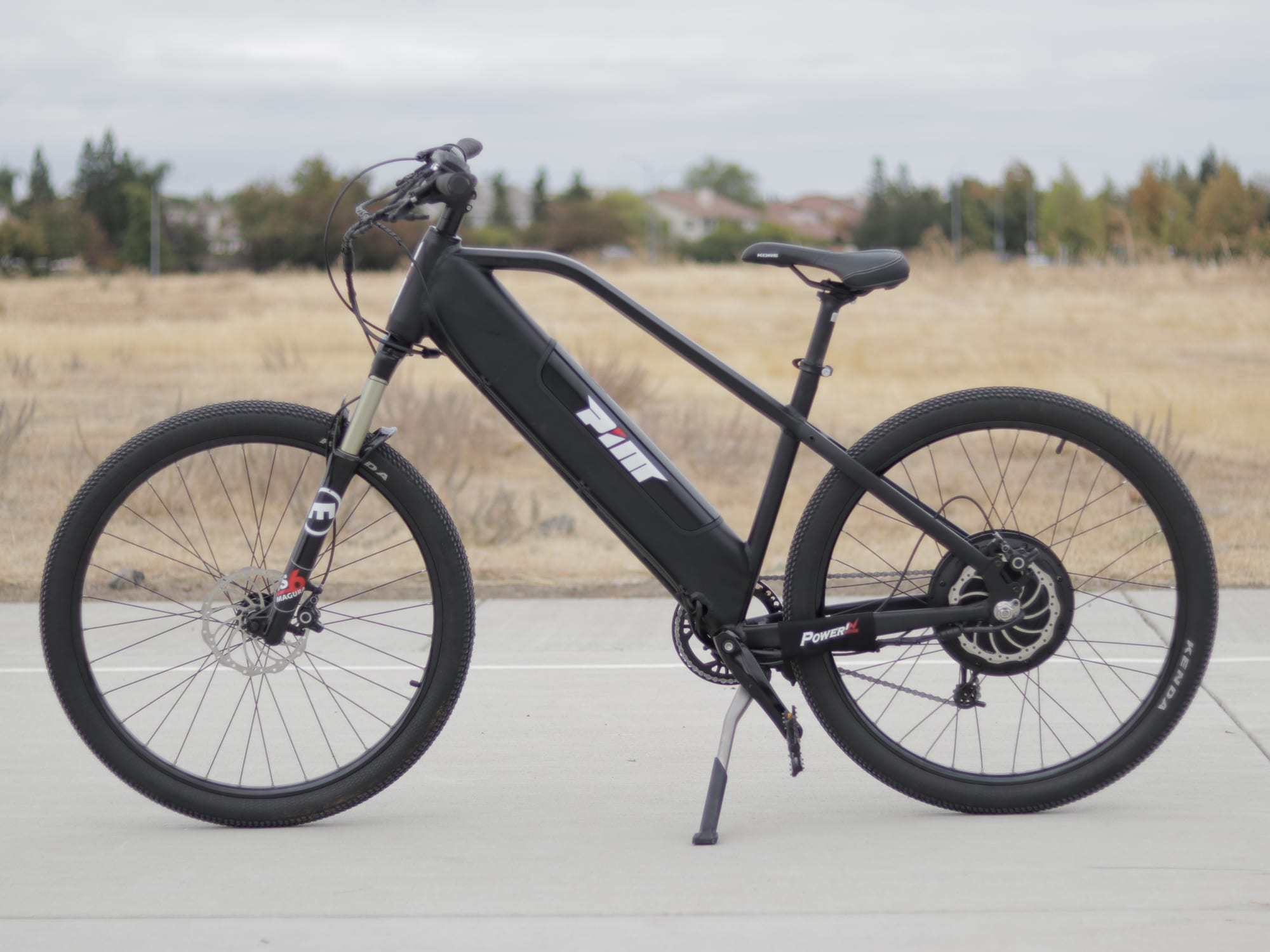
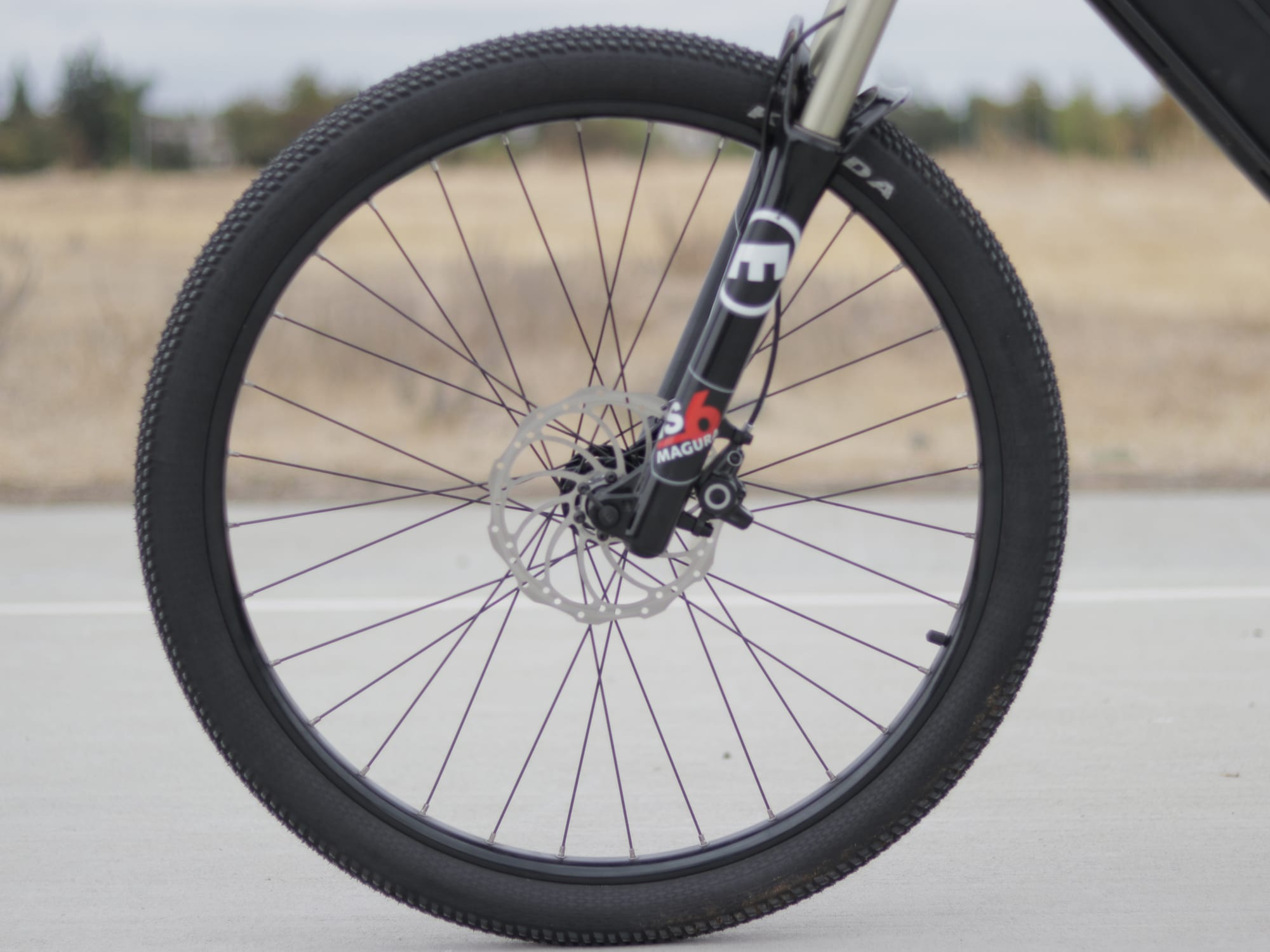
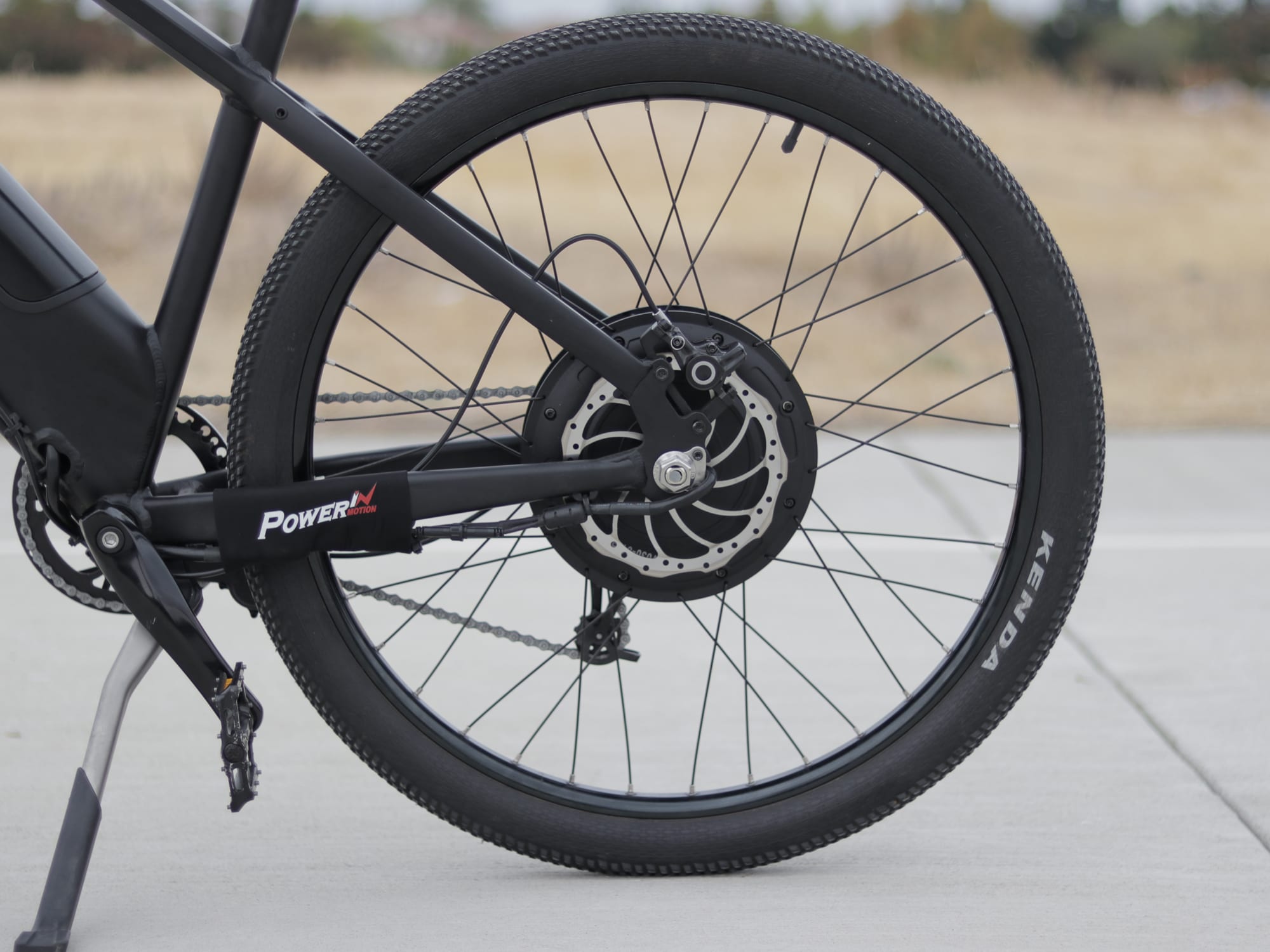
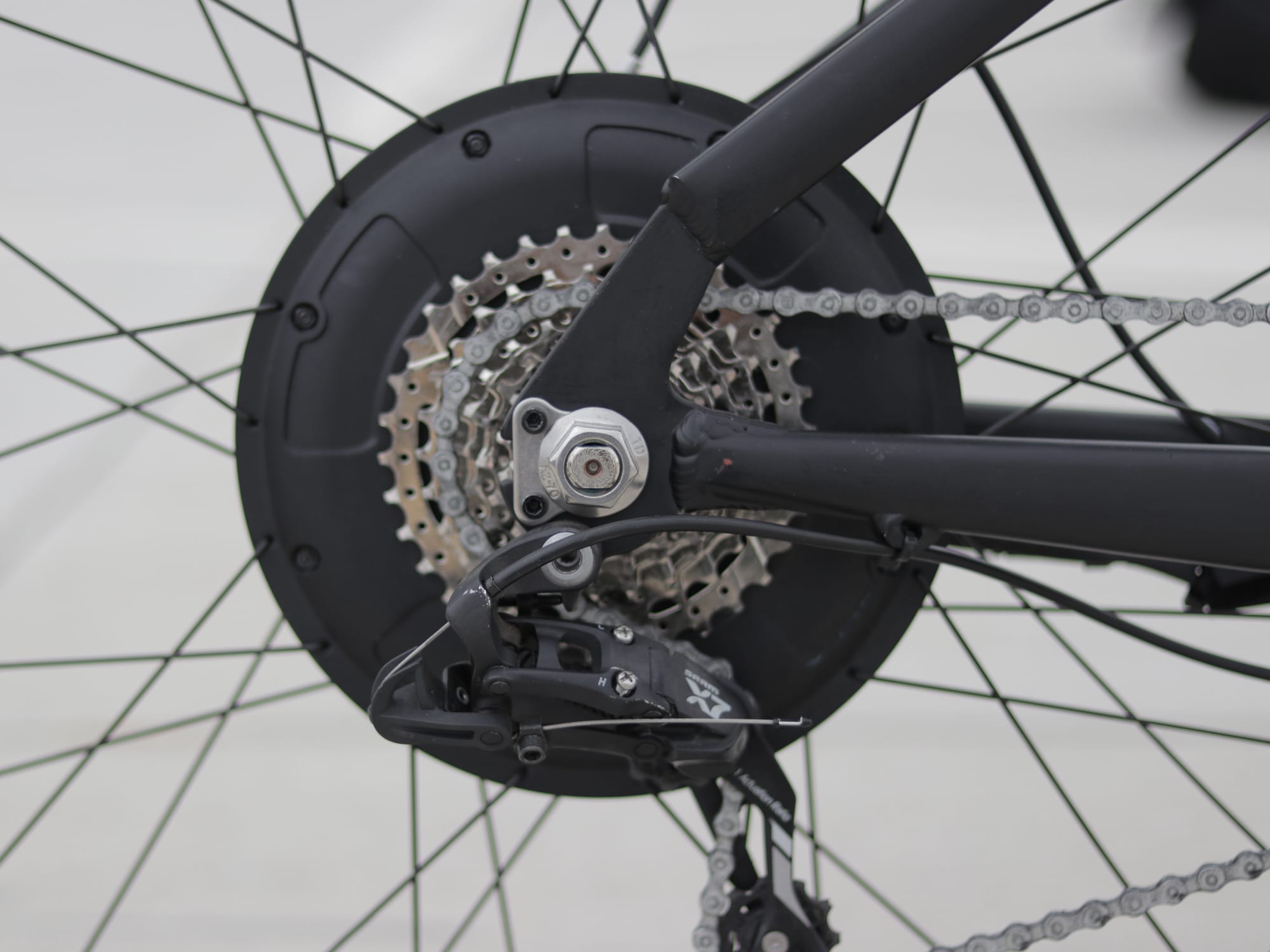

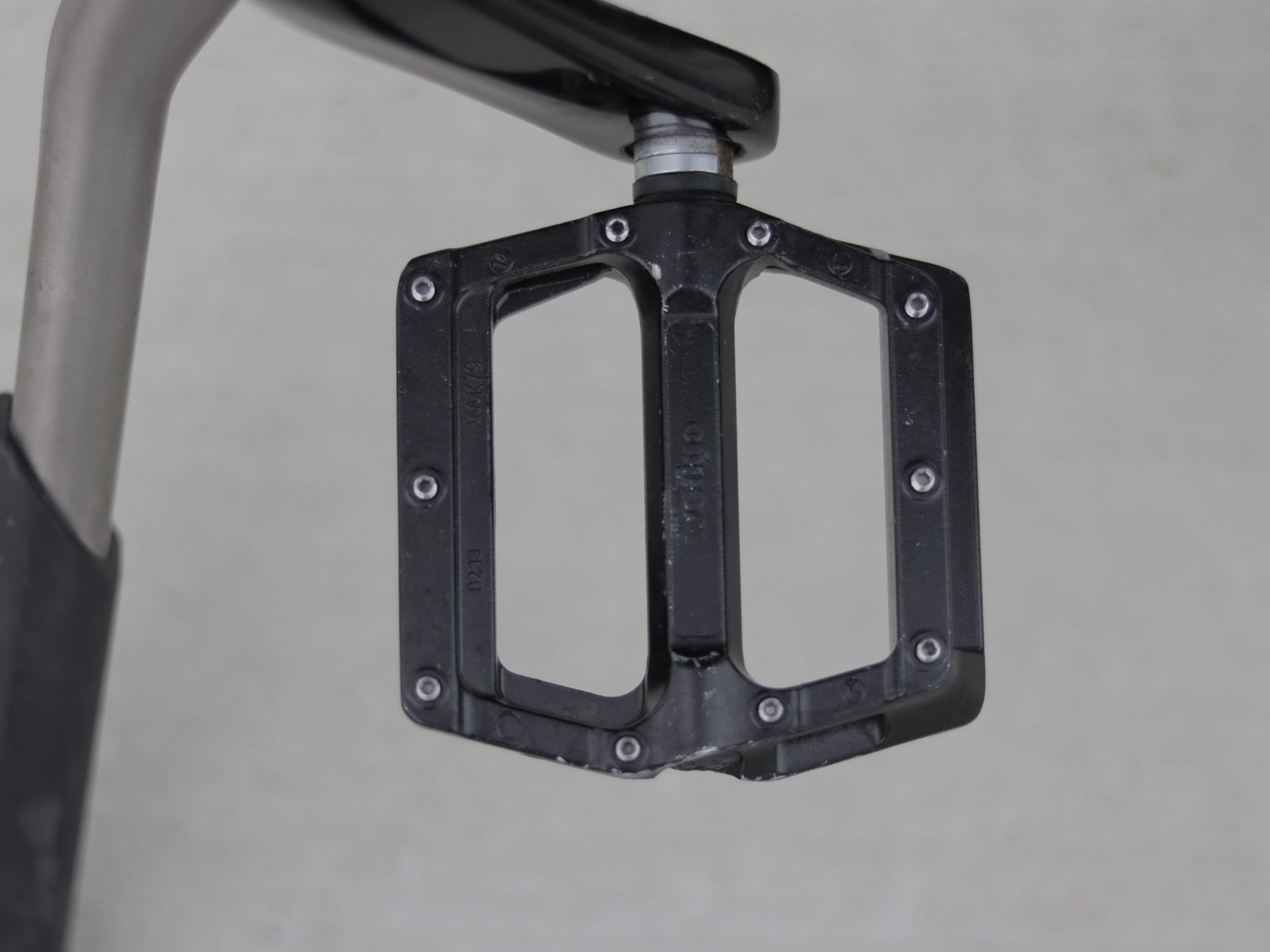

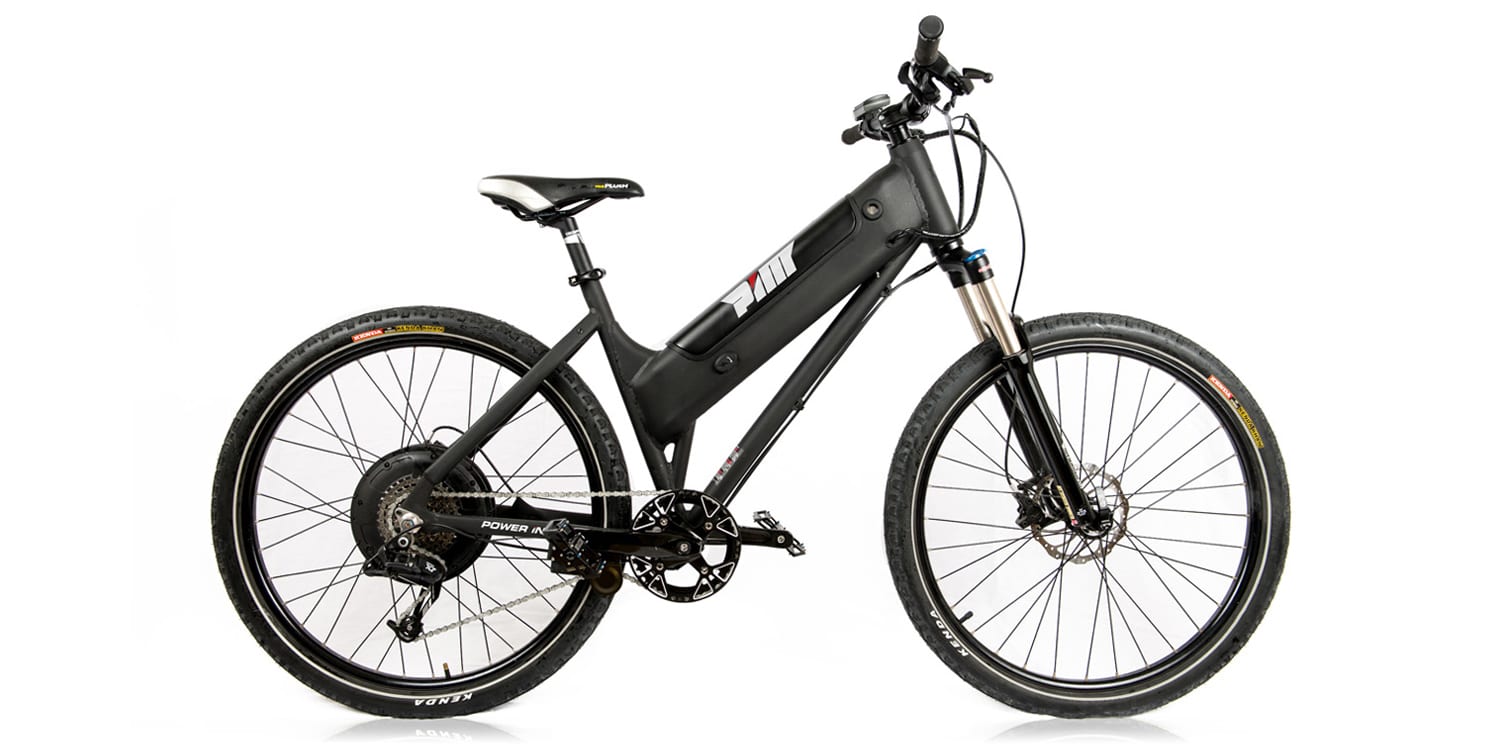
ken says
I’ve been riding a PIM eBike for about 5 months now (commute over 25 miles a day 3-4 times a week so a bit over 1000 miles already on the bike) and I’m still impressed with the quality and performance. I have the mid-step frame that looks very motorcycle-like in my opinion – subjectively I like this style because I want a burly urban commute bike that didn’t try to pretend to look like a traditional bike. I quickly installed a set of Schwalbe Moto X 27.5 x 2.4 tires which make fast street riding an amazing experience – plenty of grip and the extra air volume provides a nice ride quality without adding too much rolling resistance when at a reasonably high tire pressure.
The geometry of the PIM frame excels for urban commuting because we all know that the biking infrastructure is still lagging what they have in Europe so you need a bike that is comfortable going over curbs and zigging thru mis-aligned cross walks as well as just riding on the street when possible. I understand the benefits of mid drive motors on mountain ebikes – having unsprung weight in the rear wheel on full suspension or hard-tail eBike is not good so moving that weight to the center of the bike is a plus and this allows the motor to take advantage of the drive train when climbing. But this advantage is quickly lost when riding at speeds over 20mph because most of the torque of a mid drive motor is lost at higher gear ratios and the rear hub motor’s torque is directly applied at the rear wheel. I have a Haibike with a Yamaha PW mid-drive motor and I enjoy that bike as well but for urban commuting the PIM shines a bit brighter. Can’t wait to see faster models I here may be coming Spring 2018.
Court Rye says
Cool! Thanks for sharing your experience with the PIM ebikes and the perspective about how it compares at speed to the Yamaha PW mid-motor. Great post Ken!
Ken says
Thanks Court. You website was very influential in me buying a couple ebikes. I learned that the Polaris Diesel I purchased (a somewhat limited edition) was made in cooperation with Power In Motion and your review of the Polaris Appex influenced that purchase. I liked the appearance a lot – not that I don’t like traditional bike designs but the PIM/Polaris frame was just so unique (I grew up riding off-road motorcycles and then street motorcycles so I thought the cosmetics of the bike were impressive even though clearly not a traditional looking bike) and the powerful hub motor was also something I wanted.
Your comments on the motor continuing to provide some assist after you stop pedaling is very accurate but when you commute on the bikes as I’m doing you get use to quickly and it actually become an asset (like taking a quick breather or coasting up to a stop light). If trail riding I think the rider would just have to remember to use the brakes effectively to cut that assist off immediately when necessary.
I really like the Haibike Trekking SDuro model I bought as well (the Yamaha motor also reminded me of my dirt cycle riding days). One thing I’d like to read more about is what is the real world efficiency of hub motor to mid drive motors. With the hub always providing torque directly to the rear wheel I believe they may be more efficient overall vs a mid drive that is far more efficient using the lower gears of the bike’s drive train but at higher speeds the gear ratio actually negatively impacts torque transmission (for example if you on a 44T front chain ring and an 11T rear, 75% of the mid-drives torque is essentially loss due to the gear ratio). As hub motors are running faster the torque drops a bit (I don’t believe anywhere close to 75%) but it’s directly applied to the rear wheel and the higher speeds is also helping the motor run more efficiently. I’m just wondering if that’s why some of the high-end pedelecs like the Stromer continue to use hub motors.
Note: The Bosch mid drive may resolve a lot of the high speed dropping of torque by spinning a small front chain ring 2.5X the riders cadence but that is not fully discussed much on all the eBike websites I’ve been to. I think there system kind of levels the performance a bit – ie not quite the super strong climber the Yamaha drive system is, but at higher speeds the rider doesn’t have to work as hard because more of the motor torque is getting to the rear wheel.
Would be really cool if some with the technical back ground could actually shed light on the real world efficiencies of the drives systems (not just telling us that a mid drive motor spins faster internally so it’s more efficient than a hub drive (that is not an full drive system assessment).
Anyway, Keep up the great work and I’ll keep adding content to your site when I feel I have something +++ to add.
Court Rye says
Hi Ken! I created a video comparison on Bosch to Yamaha and Shimano which will go up soon. In my experience, most mid-drive motors beat hubs in terms of efficiency and optimizing the same capacity of a battery. The Bosch Performance Line motor does use a smaller chainring to act as a reduction gear but the other systems have internal gearing that do a similar thing. I don’t feel like it struggles to climb compared to Yamaha but I do feel that it offers a higher cadence range and is more responsive. I believe that Bosch will eventually move more of their motors to full chainring size like the new Active and Active+ models have done. The biggest benefit to hub motors that I have experienced is separation from the pedaling drivetrain which reduces stress and strain on the chain, cassette and derailleur. But again, running the system through your drivetrain creates that efficiency so it’s a trade off. I think gearless hub motors like the ones Stromer uses (and what Specialized used to use on their original Turbo) can be durable and quiet but the regenerative braking isn’t super efficient and the added rear weight becomes a burden when servicing the rear wheel or if you have a full suspension setup. I like hub motors but tend to go with geared lightweight designs for myself because I’m an active rider. They work well for throttle operation and tend to keep the price lower than mid-drives (at least for now) because they don’t require a special frame. I hope this helps to clarify :)
Anonymous says
Court Rye replied to your comment on PIM Bicycles Archer Review:
Hi Ken! I created a video comparison on Bosch to Yamaha and Shimano which will go up soon. In my experience, most mid-drive motors beat hubs in terms of efficiency and optimizing the same capacity of a battery. The Bosch Performance Line motor does use a smaller chainring to act as a reduction gear but the other systems have internal gearing that do a similar thing. I don’t feel like it struggles to climb compared to Yamaha but I do feel that it offers a higher cadence range and is more responsive. I believe that Bosch will eventually move more of their motors to full chainring size like the new Active and Active+ models have done. The biggest benefit to hub motors that I have experienced is separation from the pedaling drivetrain which reduces stress and strain on the chain, cassette and derailleur. But again, running the system through your drivetrain creates that efficiency so it’s a trade off. I think gearless hub motors like the ones Stromer uses (and what Specialized used to use on their original Turbo) can be durable and quiet but the regenerative braking isn’t super efficient and the added rear weight becomes a burden when servicing the rear wheel or if you have a full suspension setup. I like hub motors but tend to go with geared lightweight designs for myself because I’m an active rider. They work well for throttle operation and tend to keep the price lower than mid-drives (at least for now) because they don’t require a special frame. I hope this helps to clarify :)
Hi Court, I copied your response from an site email into this thread. I hope that is OK.
You are primarily correct about the inherent efficiency of the mid drive motors themselves – the internal gear reduction allows them to run faster which is a more inherently efficient state for a brushless motor. But at higher speeds that extra torque and “inherent” advantage is loss in the gear ratio of the front to rear chain rings. Let’s say a mid drive is actually providing 60nM of torque at the crank axle but the front chain ring is 44T and the rear is 11T – 75% of that torque is essentially lost via the gear ratio. A rear hub is heavier and less efficient (especially at slow speeds) but at higher speeds that improves and the torque produced by the motor is directly applied to the the rear wheel (if it’s producing just 20nM that is still more power to the rear wheel that my example mid-drive at fast speeds.
I have not attempted to assess the actual efficiencies of mid drives vs hub drives but my guess is that somewhere between 12 – 20mph the “efficientcy” (this is both a motor status as much as it is a complete system performance issue) advantage shifts to hub motors. I believe an actually real world evaluation of this is possible with the right equipment. I’m certainly interested in getting past the marketing to know what is the best solution for hill climbing ability (clearly a mid-drive strength)
as well as speed pedelec purpose built bike (interesting that Grace choose a hub motor for their fastest eBike called the Grace One that you reveiewed). Cost was not a big worry on that bike and they went with a hub motor – kind of tells me that at the speeds they expect that bike to spend a significant % of it time going the hub drive is the better option.
BOB says
I recently purchased the PIM Archer MS as my first e-bike and love the way it gets me back in the saddle. I do have a question about most effective gearing and use of the Assist modes. On flats and rolling hills the system is very intuitive, but on steep hills the system appears to struggle. Am I limited to using Assist level 1 in Gear 1 in steep hills? How should I monitor stress to the motor and battery on steep hills (think Seattle-steep)? I appreciate informed responses!